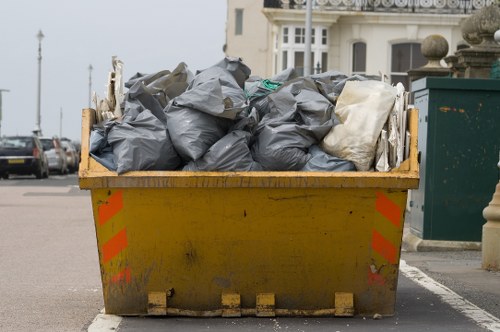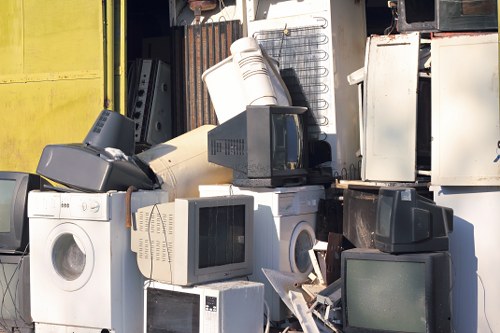Comprehensive Guide to Builders Waste Clearance in Surbiton

When undertaking a construction or renovation project in Surbiton, one critical aspect that must not be overlooked is builders waste clearance. Proper waste management not only ensures a clean and safe working environment but also contributes to environmental sustainability.
Builders waste clearance involves the removal of materials such as concrete, bricks, timber, and other construction debris. Efficient clearance services help in maintaining the project's timeline and ensuring that the site remains organized and hazard-free.
Choosing the right waste clearance company in Surbiton can make a significant difference in the project's success. It is essential to select a service that is reliable, efficient, and compliant with local regulations.

Why Builders Waste Clearance is Essential
Effective builders waste clearance is crucial for several reasons:
- Safety: Removing debris reduces the risk of accidents on the construction site.
- Compliance: Adhering to local waste disposal regulations avoids legal complications.
- Environmental Protection: Proper disposal methods minimize environmental impact.
- Efficiency: A clutter-free site enhances productivity and workflow.
Moreover, timely waste clearance can prevent project delays caused by the accumulation of materials and ensure that resources are utilized optimally.
Implementing a robust waste management plan from the outset can lead to significant long-term benefits, both financially and environmentally.

Types of Builders Waste
Builders waste encompasses a wide variety of materials generated during construction and renovation activities. Common types include:
- Concrete and Masonry: Scraps from foundations, walls, and other structural elements.
- Timber: Offcuts from framing, decking, and wooden fixtures.
- Metals: Excess metal from structural supports, plumbing, and electrical installations.
- Plastics and Packaging: Waste from insulation materials, piping, and packaging materials.
- Hazardous Materials: Asbestos, paints, solvents, and other chemicals require specialized disposal.
Understanding the types of waste generated helps in planning the appropriate clearance and disposal methods, ensuring compliance with environmental standards.
Additionally, segregating waste at the source facilitates recycling and reduces the overall environmental footprint of the construction project.

Choosing the Right Waste Clearance Service in Surbiton
Selecting a reputable waste clearance service in Surbiton involves considering several factors:
- Experience: Companies with extensive experience are more likely to handle diverse waste types efficiently.
- Licensing and Certification: Ensure the service is licensed to handle and dispose of construction waste.
- Service Range: Comprehensive services including collection, transportation, and disposal are preferable.
- Recycling Efforts: Opt for services that prioritize recycling and environmentally friendly disposal methods.
- Customer Reviews: Positive feedback indicates reliability and quality of service.
Additionally, it's beneficial to inquire about the company's policies on waste segregation and their ability to customize services based on project needs.
Transparent pricing and clear communication are also essential aspects to consider when choosing a waste clearance provider.

Steps Involved in Builders Waste Clearance
The process of builders waste clearance typically involves the following steps:
- Assessment: Evaluating the volume and types of waste generated.
- Scheduling: Planning the clearance timeline to align with project milestones.
- Collection: Gathering waste materials from the construction site.
- Transportation: Moving waste to appropriate disposal or recycling facilities.
- Disposal: Properly disposing of or recycling materials in compliance with regulations.
Each step is crucial to ensure that waste is managed efficiently and responsibly. Proper coordination among all parties involved can streamline the clearance process and minimize disruptions to the construction workflow.
Implementing best practices in each stage enhances the overall effectiveness of the waste management strategy.
Benefits of Professional Builders Waste Clearance
Engaging professional waste clearance services offers numerous advantages:
- Expertise: Professionals are trained to handle various waste types safely and efficiently.
- Time-Saving: Outsourcing clearance allows project teams to focus on core activities.
- Cost-Effective: Prevents potential fines and reduces costs associated with improper waste disposal.
- Environmental Stewardship: Ensures that waste is managed in an eco-friendly manner, supporting sustainability goals.
- Compliance: Guarantees adherence to local and national waste management laws and standards.
Additionally, professional services often provide comprehensive reporting, helping businesses track their waste management efforts and identify areas for improvement.
These benefits collectively contribute to the smooth execution and successful completion of construction projects.
Environmental Impact of Builders Waste Clearance
Effective builders waste clearance plays a significant role in minimizing the environmental impact of construction activities:
- Reduction of Landfill Use: Recycling and reusing materials decrease the reliance on landfills.
- Energy Conservation: Recycling materials often requires less energy compared to producing new materials.
- Pollution Prevention: Proper handling of hazardous waste prevents soil and water contamination.
- Resource Efficiency: Maximizing the use of existing materials conserves natural resources.
Moreover, sustainable waste management practices contribute to the broader goals of reducing carbon footprints and promoting green construction methodologies.
By prioritizing environmental considerations, builders waste clearance supports responsible construction and long-term ecological balance.
Local Regulations for Builders Waste Clearance in Surbiton
Surbiton, like many other regions, has specific regulations governing builders waste clearance. Adhering to these regulations is imperative to avoid legal issues and ensure sustainable practices.
- Waste Segregation: Mandatory separation of different waste types for appropriate disposal.
- Licensing Requirements: Only licensed companies can handle and transport certain types of waste.
- Disposal Standards: Specific guidelines on how various materials should be disposed of or recycled.
- Documentation: Proper record-keeping and reporting of waste handling activities.
- Penalties: Fines and legal actions for non-compliance with waste management laws.
Staying informed about local regulations and working with compliant waste clearance services ensures that businesses meet their legal obligations and uphold environmental standards.
Regular audits and reviews of waste management practices can help maintain compliance and identify opportunities for improvement.
Sustainable Practices in Builders Waste Clearance
Incorporating sustainable practices in builders waste clearance enhances environmental responsibility and promotes long-term viability:
- Recycling: Diverting materials like metal, wood, and concrete from landfills through recycling programs.
- Reuse: Repurposing materials for new projects or donating them to reduce waste.
- Energy Recovery: Utilizing waste-to-energy technologies to convert waste into usable energy.
- Minimization: Implementing strategies to reduce waste generation at the source.
- Compliance: Ensuring that all practices meet or exceed environmental regulations.
Adopting these practices not only benefits the environment but also enhances the reputation of businesses committed to sustainability.
Continuous improvement and innovation in waste management techniques are key to achieving greater sustainability in the construction industry.
Cost Considerations for Builders Waste Clearance
Budgeting for builders waste clearance is an essential aspect of project planning. Several factors influence the overall cost:
- Volume of Waste: Larger projects generate more waste, increasing clearance costs.
- Type of Waste: Hazardous and special waste types may incur additional fees.
- Service Frequency: Regular clearance schedules can affect pricing structures.
- Recycling Rates: Higher recycling efforts may lead to cost savings through reduced landfill fees.
- Contract Terms: Long-term contracts might offer discounted rates.
It is advisable to obtain detailed quotes from multiple service providers to compare costs and services offered. Transparent pricing ensures that there are no hidden fees and that the budget aligns with project requirements.
Investing in efficient waste clearance services can lead to long-term savings by preventing project delays and avoiding potential fines.
Choosing Eco-Friendly Builders Waste Clearance Options
Prioritizing eco-friendly waste clearance options aligns construction projects with sustainable development goals:
- Recycling Programs: Partnering with services that have robust recycling initiatives.
- Green Certifications: Selecting companies with environmental certifications and credentials.
- Waste Audits: Conducting regular waste audits to identify areas for improvement.
- Sustainable Disposal: Ensuring that waste is disposed of in environmentally responsible ways.
- Innovation: Utilizing the latest technologies and methods in waste management.
These eco-friendly approaches contribute to reducing the carbon footprint of construction projects and fostering a culture of environmental responsibility.
Implementing sustainable waste clearance practices can also enhance the marketability and appeal of construction projects to environmentally conscious stakeholders.
Case Studies: Successful Builders Waste Clearance in Surbiton
Examining successful case studies provides valuable insights into effective builders waste clearance strategies:
- Residential Renovation Project: Managed waste clearance efficiently by segregating materials and recycling 80% of the waste.
- Commercial Construction: Implemented a comprehensive waste management plan that reduced landfill waste by 70%.
- Green Building Initiative: Achieved zero waste to landfill through advanced recycling and reuse practices.
These examples demonstrate the practical application of waste clearance principles and highlight the benefits of meticulous planning and execution.
Learning from these case studies can help other projects adopt best practices and avoid common pitfalls in waste management.
Future Trends in Builders Waste Clearance
The builders waste clearance industry is evolving with emerging trends that focus on enhanced sustainability and efficiency:
- Advanced Recycling Technologies: Innovations that improve the efficiency and effectiveness of recycling processes.
- Digital Waste Management: Utilizing software and analytics to optimize waste tracking and management.
- Circular Economy Practices: Emphasizing the continuous use and reuse of materials to minimize waste.
- Green Certifications: Increasing demand for services that adhere to stringent environmental standards.
- Automation: Incorporating automation in waste collection and sorting to enhance productivity.
Staying abreast of these trends enables builders and waste clearance services to adopt innovative practices that drive sustainability and operational excellence.
Embracing these advancements can lead to more efficient waste management strategies and better environmental outcomes.
FAQs about Builders Waste Clearance in Surbiton
1. What types of waste are included in builders waste clearance?
Builders waste clearance includes materials like concrete, bricks, timber, metals, plastics, and hazardous substances. Proper segregation is essential for effective disposal and recycling.
2. How often should builders waste be cleared from a construction site?
The frequency of waste clearance depends on the project's size and duration. However, regular clearance schedules, such as weekly or bi-weekly, are recommended to maintain a safe and organized site.
3. Are there eco-friendly options available for builders waste clearance?
Yes, many waste clearance services offer eco-friendly options, including recycling, reuse, and environmentally responsible disposal methods to minimize the environmental impact.
4. How can I find a reliable builders waste clearance service in Surbiton?
Researching local companies, checking reviews, verifying licenses and certifications, and comparing services are effective ways to find a reliable waste clearance service in Surbiton.
Conclusion
Effective builders waste clearance is a fundamental component of successful construction and renovation projects in Surbiton. By prioritizing safety, compliance, and sustainability, businesses can ensure smooth operations and contribute positively to the environment.
Choosing the right waste clearance service, understanding local regulations, and adopting eco-friendly practices are essential steps in achieving optimal waste management. Investing in professional services not only enhances project efficiency but also aligns with broader sustainability goals.
For comprehensive and reliable builders waste clearance in Surbiton, contact us today to ensure your project remains clean, compliant, and environmentally responsible.
Book your service now and take the first step towards efficient and sustainable waste management.